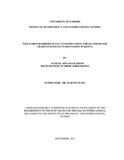| dc.contributor.author | Matama, Clairette N | |
| dc.date.accessioned | 2013-01-03T11:45:20Z | |
| dc.date.available | 2013-07-07T22:00:19Z | |
| dc.date.issued | 2013-01-03 | |
| dc.identifier.uri | http://erepository.uonbi.ac.ke:8080/xmlui/handle/123456789/7428 | |
| dc.description.abstract | “The world is a global village” is a common phrase that goes around nowadays. Borders are beginning to become less and less restrictive as countries realize the benefits of less restriction to cross border trade. The European Union has paved a path that countries around the world might follow in the next few years to come. The East African region nations are united in a customs union in a bid to increase the ease of cross border trade between Kenya, Uganda and Tanzania.
The East African Community (EAC) was formed in 2001, revamped after a collapse in 1977. It was officially launched in 2005. Kenya, Uganda and Tanzania resolved to create an enabling environment to attract foreign investors, allow private and civil society to play a leading role in development and to stimulate trade between the three countries. They signed a customs union protocol in March 2004. This paper surveys retail institutions in Nairobi’s Central Business District (NCBD) in a bid to establish the perceptions of traders to the East Africa Community Customs Union and the factors that influence this perception.
Chapter 1 of the study provides a brief background on the East African Community, its origins and the formation of the customs union. It also provided an insight into retail trade in Nairobi. The chapter also defines the problem. Chapter 2 builds the theoretical framework of the problem by providing literary works on regional integration, its benefits and flaws; the effect of customs union; and trade within the EAC. Chapter 3 defines the research methodology of the study.
The fourth chapter presents the data analysis and findings of the study. The analysis entails primarily quantitative methods of analysis. The findings are then discussed in Chapter 5, which is a summary of findings, conclusions and recommendations. | en |
| dc.language.iso | en | en |
| dc.subject | EAST AFRICAN COMMUNITY | en |
| dc.subject | CUSTOMS UNION | en |
| dc.subject | NAIROBI CENTRAL BUSINESS DISTRICT | en |
| dc.subject | “The world is a global village” is a common phrase that goes around nowadays. Borders are beginning to become less and less restrictive as countries realize the benefits of less restriction to cross border trade. The European Union has paved a path that countries around the world might follow in the next few years to come. The East African region nations are united in a customs union in a bid to increase the ease of cross border trade between Kenya, Uganda and Tanzania. The East African Community (EAC) was formed in 2001, revamped after a collapse in 1977. It was officially launched in 2005. Kenya, Uganda and Tanzania resolved to create an enabling environment to attract foreign investors, allow private and civil society to play a leading role in development and to stimulate trade between the three countries. They signed a customs union protocol in March 2004. This paper surveys retail institutions in Nairobi’s Central Business District (NCBD) in a bid to establish the perceptions of traders to the East Africa Community Customs Union and the factors that influence this perception. Chapter 1 of the study provides a brief background on the East African Community, its origins and the formation of the customs union. It also provided an insight into retail trade in Nairobi. The chapter also defines the problem. Chapter 2 builds the theoretical framework of the problem by providing literary works on regional integration, its benefits and flaws; the effect of customs union; and trade within the EAC. Chapter 3 defines the research methodology of the study. The fourth chapter presents the data analysis and findings of the study. The analysis entails primarily quantitative methods of analysis. The findings are then discussed in Chapter 5, which is a summary of findings, conclusions and recommendations. | en |
| dc.title | Perception of east African community customs union: A case study of retailers in Nairobi central business district | en |
| dc.type | Thesis | en |
| local.embargo.terms | 6 months | en |




